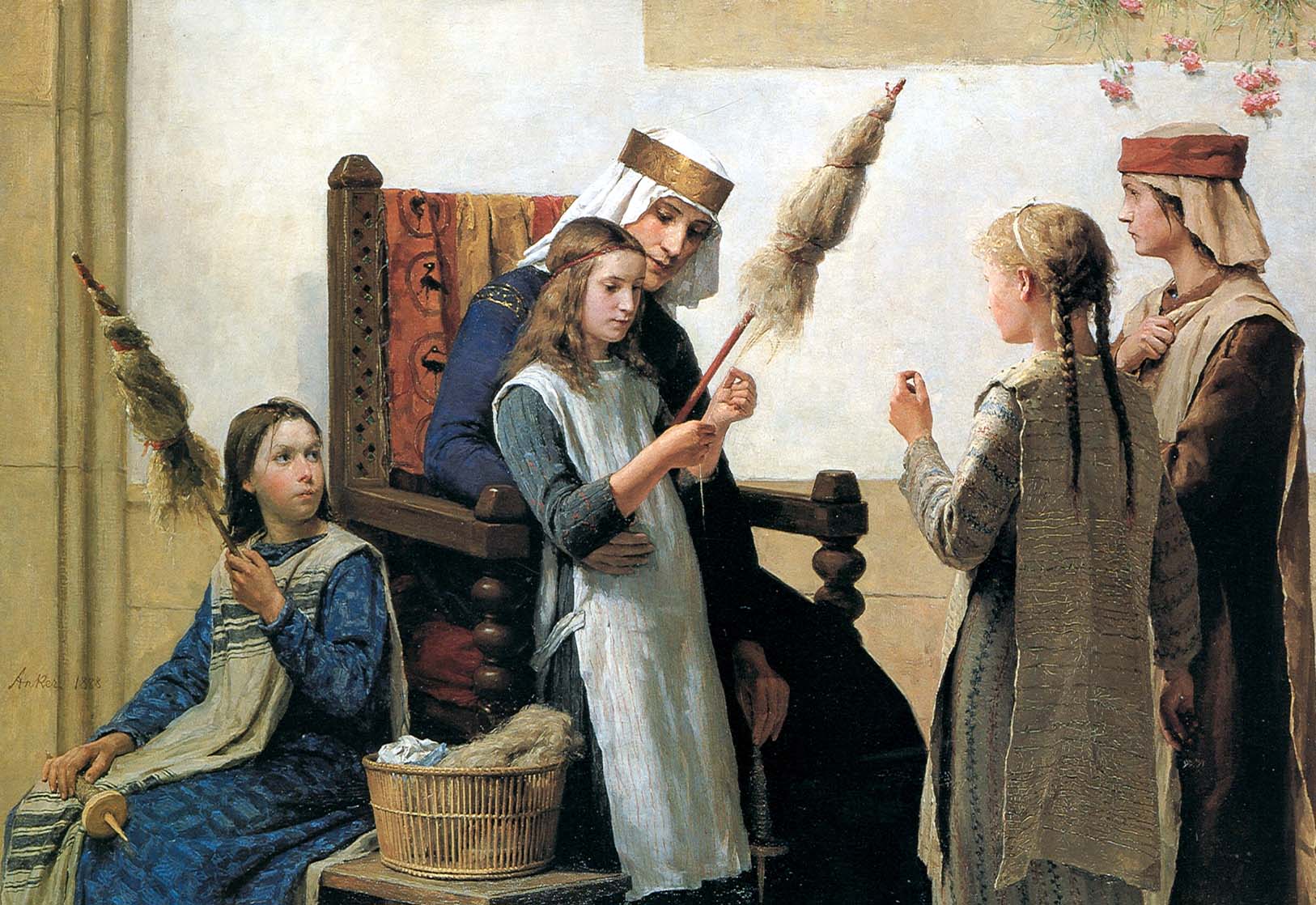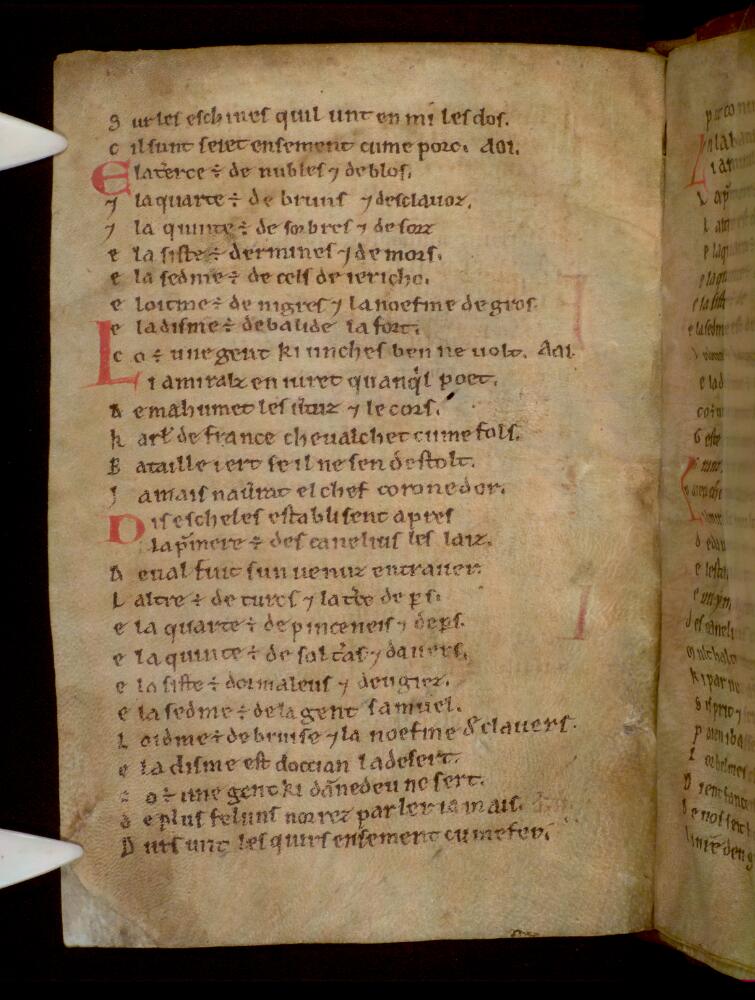|
The Distaff Gospels
''The Distaff Gospels (Les Evangiles des Quenouilles)'' is an Old French fifteenth-century collection of popular beliefs held by late medieval women, first published in 1480. It was edited by Fouquart de Cambray, Duval Antoine and Jean d'Arras and published at Bruges by Colart Mansion. The narrative takes place within the context of a gathering of women who meet with their spindles and distaffs to spin. They discuss folk wisdom Folklore is shared by a particular group of people; it encompasses the traditions common to that culture, subculture or group. This includes oral traditions such as tales, legends, proverbs and jokes. They include material culture, ranging fr ... related to their domestic lives, including controlling errant husbands, predicting the gender of future offspring and curing common ailments. Editions *''Les évangiles des quenouilles''. Paris: P. Jannet, 1855 *''Les Evangiles des quenouilles''; édition critique, introduction et notes par Madeleine Jeay. ... [...More Info...] [...Related Items...] OR: [Wikipedia] [Google] [Baidu] |
Old French
Old French (, , ; Modern French: ) was the language spoken in most of the northern half of France from approximately the 8th to the 14th centuries. Rather than a unified language, Old French was a linkage of Romance dialects, mutually intelligible yet diverse, spoken in the northern half of France. These dialects came to be collectively known as the , contrasting with the in the south of France. The mid-14th century witnessed the emergence of Middle French, the language of the French Renaissance in the Île de France region; this dialect was a predecessor to Modern French. Other dialects of Old French evolved themselves into modern forms (Poitevin-Saintongeais, Gallo, Norman, Picard, Walloon, etc.), each with its own linguistic features and history. The region where Old French was spoken natively roughly extended to the northern half of the Kingdom of France and its vassals (including parts of the Angevin Empire, which during the 12th century remained under Anglo-Norman rul ... [...More Info...] [...Related Items...] OR: [Wikipedia] [Google] [Baidu] |
Late Middle Ages
The Late Middle Ages or Late Medieval Period was the Periodization, period of European history lasting from AD 1300 to 1500. The Late Middle Ages followed the High Middle Ages and preceded the onset of the early modern period (and in much of Europe, the Renaissance). Around 1300, centuries of prosperity and growth in Europe came to a halt. A series of famines and Plague (disease), plagues, including the Great Famine of 1315–1317 and the Black Death, reduced the population to around half of what it had been before the calamities. Along with depopulation came social unrest and endemic warfare. France and England experienced serious peasant uprisings, such as the Jacquerie and the Peasants' Revolt, as well as over a century of intermittent conflict, the Hundred Years' War. To add to the many problems of the period, the unity of the Catholic Church was temporarily shattered by the Western Schism. Collectively, those events are sometimes called the Crisis of the Late Middle Ages. D ... [...More Info...] [...Related Items...] OR: [Wikipedia] [Google] [Baidu] |
Colard Mansion
Colard Mansion (or Colart, before 1440 – after May 1484) was a 15th-century Flemish scribe and printer who worked together with William Caxton. He is known as the first printer of a book with copper engravings, and as the printer of the first books in English and French. Biography Colard Mansion was a central figure in the early printing industry in Bruges. He was active as early as 1454 as a bookseller, and was also active as a scribe, translator and contractor for manuscripts, which meant entering into contracts with the clients, and organizing and sub-contracting the elements such as scribing, decorating and binding. From 1474 until 1476 he worked together with the early English printer William Caxton, and he continued the company on his own afterwards. Caxton probably learned the art of printing from Mansion, and it was from Mansion's press that the first books printed in English (''Recuyell of the Historyes of Troye'') and French came. He moved to the Burg, the commerci ... [...More Info...] [...Related Items...] OR: [Wikipedia] [Google] [Baidu] |
Spindle (textiles)
A spindle is a straight spike usually made from wood used for spinning (textiles), spinning, twisting fibers such as wool, flax, hemp, cotton into Thread (yarn), yarn. It is often weighted at either the bottom, middle, or top, commonly by a disc or spherical object called a spindle whorl, whorl; many spindles, however, are weighted simply by thickening their shape towards the bottom, e.g. Orenburg and French spindles. The spindle may also have a hook, groove, or notch at the top to guide the yarn. Spindles come in many different sizes and weights depending on the thickness of the yarn one desires to spin. History The origin of the first wooden spindle is lost to history because the materials did not survive. Whorl-weighted spindles date back at least to Neolithic times; spindle whorls have been found in archaeological digs around the world. A spindle is also part of traditional spinning wheels where it is horizontal, such as the Indian charkha and the great or walking wheel. ... [...More Info...] [...Related Items...] OR: [Wikipedia] [Google] [Baidu] |
Distaff
A distaff (, , also called a rock"Rock." ''The Oxford English Dictionary''. 2nd ed. 1989.), is a tool used in spinning. It is designed to hold the unspun fibers, keeping them untangled and thus easing the spinning process. It is most commonly used to hold flax and sometimes wool, but can be used for any type of fibre. Fiber is wrapped around the distaff and tied in place with a piece of ribbon or string. The word comes from Low German ''dis'', meaning a bunch of flax, connected with staff. As an adjective, the term ''distaff'' is used to describe the female side of a family. The corresponding term for the male side of a family is the "spear" side. Form In Western Europe, there were two common forms of distaves, depending on the spinning method. The traditional form is a staff held under one's arm while using a spindle – see the figure illustration. It is about long, held under the left arm, with the right hand used in drawing the fibres from it."Distaff." ''The Oxford Engli ... [...More Info...] [...Related Items...] OR: [Wikipedia] [Google] [Baidu] |
Folk Wisdom
Folklore is shared by a particular group of people; it encompasses the traditions common to that culture, subculture or group. This includes oral traditions such as tales, legends, proverbs and jokes. They include material culture, ranging from traditional building styles common to the group. Folklore also includes customary lore, taking actions for folk beliefs, the forms and rituals of celebrations such as Christmas and weddings, folk dances and initiation rites. Each one of these, either singly or in combination, is considered a folklore artifact or traditional cultural expression. Just as essential as the form, folklore also encompasses the transmission of these artifacts from one region to another or from one generation to the next. Folklore is not something one can typically gain in a formal school curriculum or study in the fine arts. Instead, these traditions are passed along informally from one individual to another either through verbal instruction or demonstrati ... [...More Info...] [...Related Items...] OR: [Wikipedia] [Google] [Baidu] |
Medieval French Literature
Medieval French literature is, for the purpose of this article, Medieval literature written in Oïl languages (particularly Old French and early Middle French) during the period from the eleventh century to the end of the fifteenth century. The material and cultural conditions in France and associated territories around the year 1100 unleashed what the scholar Charles Homer Haskins termed the " Renaissance of the 12th century" and, for over the next hundred years, writers, " jongleurs", "clercs" and poets produced a profusion of remarkable creative works in all genres. Although the dynastic struggles of the Hundred Years' War and the Black Death pandemic of the fourteenth century in many ways curtailed this creative production, the fifteenth century laid the groundwork for the French Renaissance. Language Up to roughly 1340, the Romance languages spoken in the Middle Ages in the northern half of what is today France are collectively known as "ancien français" ("Old French") ... [...More Info...] [...Related Items...] OR: [Wikipedia] [Google] [Baidu] |
Spinning
Spin or spinning most often refers to: * Spinning (textiles), the creation of yarn or thread by twisting fibers together, traditionally by hand spinning * Spin, the rotation of an object around a central axis * Spin (propaganda), an intentionally biased portrayal of something Spin, spinning or spinnin may also refer to: Physics and mathematics * Spin, the rotation of an object around a central axis * Spin (physics) or particle spin, a fundamental property of elementary particles * Spin group, a particular double cover of the special orthogonal group SO(''n'') * Spin tensor, a tensor quantity for describing spinning motion in special relativity and general relativity * Spin (aerodynamics), autorotation of an aerodynamically stalled aeroplane * SPIN bibliographic database, an indexing and abstracting service focusing on physics research Textile arts * Spinning (polymers), a process for creating polymer fibres * Spinning (textiles), the creation of yarn or thread by twisting fibe ... [...More Info...] [...Related Items...] OR: [Wikipedia] [Google] [Baidu] |
1480 Books
*
{{Number disambiguation ...
148 may refer to: *148 (number), a natural number *AD 148, a year in the 2nd century AD *148 BC, a year in the 2nd century BC *148 (album), an album by C418 *148 (Meiktila) Battery Royal Artillery *148 (New Jersey bus) See also * List of highways numbered 148 The following highways are numbered 148: Argentina * National Route 148 (Argentina), National Route 148 Canada * New Brunswick Route 148 * Ontario Highway 148 * Prince Edward Island Route 148 * Quebec Route 148 Costa Rica * National Route 148 ( ... [...More Info...] [...Related Items...] OR: [Wikipedia] [Google] [Baidu] |
Textiles In Folklore
Mention of textiles in folklore is ancient, and its lost mythic lore probably accompanied the early spread of this art. Textiles have also been associated in several cultures with spiders in mythology. Weaving begins with spinning. Until the spinning wheel was invented in the 14th century, all spinning was done with distaff and spindle. In English the "distaff side" indicates relatives through one's mother, and thereby denotes a woman's role in the household economy. In Scandinavia, the stars of Orion's belt are known as ''Friggjar rockr'', "Frigg’s distaff". The spindle, essential to the weaving art, is recognizable as an emblem of security and settled times in a ruler's eighth-century BCE inscription at Karatepe: "In those places which were formerly feared, where a man fears... to go on the road, in my days even women walked with spindles" In the adjacent region of North Syria, historian Robin Lane Fox remarks funerary stelae showing men holding cups as if feasting and wome ... [...More Info...] [...Related Items...] OR: [Wikipedia] [Google] [Baidu] |
Magic (supernatural)
Magic, sometimes spelled magick, is an ancient praxis rooted in sacred rituals, spiritual divinations, and/or cultural lineage—with an intention to invoke, manipulate, or otherwise manifest supernatural forces, beings, or entities in the natural, incarnate world. It is a categorical yet often ambiguous term which has been used to refer to a wide variety of beliefs and practices, frequently considered separate from both religion and science. Although connotations have varied from positive to negative at times throughout history, magic continues to have an important religious and medicinal role in many cultures today. Within Western culture, magic has been linked to ideas of the Other, foreignness, and primitivism; indicating that it is "a powerful marker of cultural difference" and likewise, a non-modern phenomenon. During the late nineteenth and early twentieth century, Western intellectuals perceived the practice of magic to be a sign of a primitive mentality and also comm ... [...More Info...] [...Related Items...] OR: [Wikipedia] [Google] [Baidu] |







